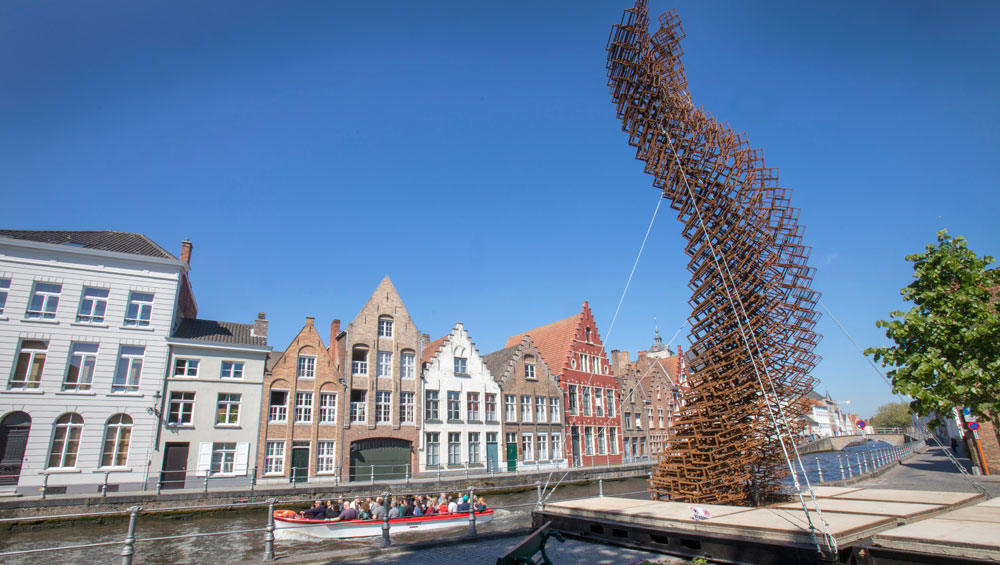
by ANNA McNAY
Inspired by the many almshouses of Bruges – the idea of medieval social housing and a sense of civic ownership that survives to this day – New York-based artist John Powers (b1970, Chicago) further drew on the city’s folkloric story of the beheading of Pieter Lanchals. A confidant of Emperor Maximilian I, Lanchals was decapitated by the people of Bruges and, as a form of punishment and remembrance, Maximilian obliged the city to keep 52 white swans on its canals in perpetuity. Powers’ site-specific work for this year’s triennial is named after the legend and echoes the elegant S-curve of a swan’s neck.
Studio International spoke to Powers, who expanded on his inspirations, talked about his process of planning and constructing the 15-metre-tall steel tower, and explained how Lanchals fits into his wider practice.
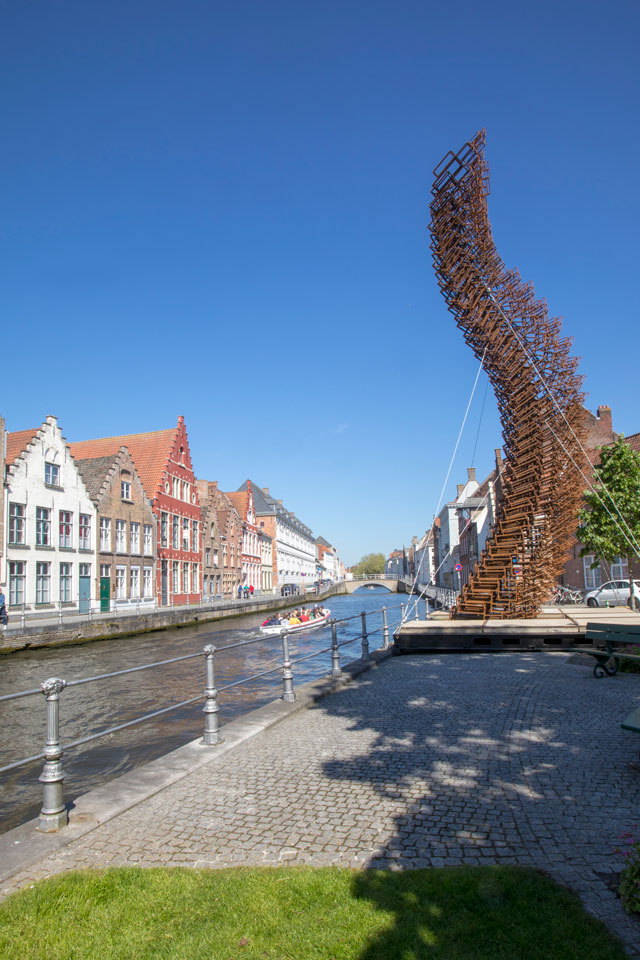
John Powers. Lanchals, 2018. Steel, 1500 cm high. Photograph © VisitBruges | Jan D’hondt.
Anna McNay: How did you first come to be invited to participate in the triennial?
John Powers: Till-Holger Borchert, the director-general of Musea Brugge, saw my work when I showed it in Brussels years ago, maybe in 2005. He reached out to me then. We met once in New York a couple of years later – well before the revived triennial was a twinkle in anyone’s eye – and we stayed in touch. He contacted me two years ago saying he had a project he’d like to talk about, and he sent me an early draft of his ideas for Liquid City.
AMc: Had you visited Bruges before?
JP: No. I’d seen the movie In Bruges at some point. I wasn’t a fan of Colin Farrell, so I think I only saw it because Till had reached out and I was trying to figure out where he was coming from. Either way, the film didn’t leave me with any insights about the place – I seem to remember thinking the city’s tourist board must have been talked into paying for the film without knowing what it was going to be about. (I did like the film, however – and I have grown to like Farrell’s work since – he’s mellowed and become a more interesting actor as he’s aged.)
AMc: What were you shown when you came on the city tour and how quickly did the idea for your work take shape?
JP: I visited for three or four days and walked around the city with the head of the technical team, Santiago de Waele, who grew up there. We talked about available sites (almost everywhere and anywhere), about the history of the city, but also about growing up there, living there, about the character of the city and the people. I had gone expecting to be shown a medieval city, something pre-modern, but I was very surprised by the city Santi showed me. It is an edge space; a city not just on the estuary geographically, but also historically. It took me a day or two to understand what I was seeing – that Bruges isn’t a late-medieval city, it’s an early modern one; that the towers I was seeing looked like religious architecture, but most of them and, importantly, the tallest one especially, were entirely secular. That was a wonderful surprise.
AMc: What are the key ideas behind your work?
JP: I sometimes tell people I make work about abstraction, which is to say about modernity. But I don’t mean modernism, I mean modernity. I’ve come to believe that modernity and urbanism are inseparable, but I’m not sure what that says about what I do. But these are the things I think about while I work, the ideas that inspire me; all the different things it has meant to be modern – the crazy utopians, the absolutism, all the conceptual dead ends that seemed so obviously true, until they didn’t. There are other, more illustrative ways to engage with those ideas, I suppose; I’m not well suited to do them, however. Making abstract art, the attempt to carry that art forward, is, I believe, the only way to live those ideas, because abstraction is native to the modern era. I enjoy [the literary scholar and media theorist] Friedrich Kittler’s scheme of optical media that pushes the origin of movies back to pre-modern times, with mystery plays and other magic lantern spectacles. Likewise, David Hockney’s theory that the history of photography dates back to the use of lenses in painting – probably as far back as the Coptic Egyptians – is irresistible to me. You can point to abstract shapes in prehistory, but abstraction isn’t a technology or technique, abstraction is more an ethos (striving to be a virtue).
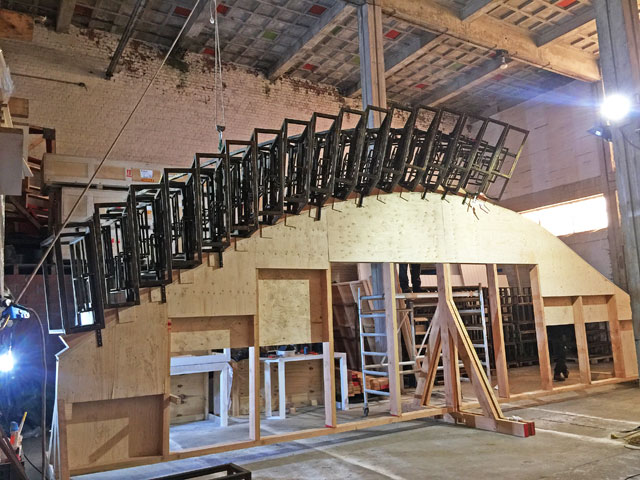
John Powers. Lanchals, construction view. Image courtesy John Powers.
AMc: How key is the idea of the civic? Civic ownership, for example, rather than private ownership. And how does this perhaps reflect or comment on contemporary society more widely?
JP: For my own personal morale and sanity, it has been key. I am not an enemy of personal wealth – I’ve never experienced it, but I don’t resent that others do. But I do resent poverty – that a society as wealthy as the US allows people to fall so far, to suffer so entirely deeply, and so entirely unnecessarily breaks my heart. Since the election, I’ve tried to put my finger on the ideology that has taken us to such a grim place, to name it. “Billionaire” seems the best label for the nihilism that is destroying our civic life. The contemporary vision of a klatch of men and families, cut free of all restraint, with the spending power of nations – either as heroes or villains – is septic. I started talking about this more than a decade ago. Gini coefficients and other ideas found their way into the titles I was choosing, as a way to work them into artist talks I was giving. (I spent a lot of time talking about artists as a class of poor people that rich people like.) But the past two years have been dispiriting. I cannot imagine what I would have done, if I had spent the months since the election, working on a 15-metre-tall tower for a billionaire. Knowing, instead, that I was working on an expression of civic wealth, was profoundly encouraging to me. But that it was for Bruges was of particular importance.

John Powers. Lanchals, construction view. Image courtesy John Powers.
When Santi and I did our tour of Bruges, he walked me past a group of very small townhouses, clustered around a tiny courtyard. He mentioned casually that it was “social housing” dating back to 1250 (or some such). He would have walked on (this was not a possible site), but I was stopped short. I thought perhaps there was a misunderstanding – that something was being lost in translation – and asked him to explain what he meant. He said: “You know, when rich people pay for poor people to have a place to live.” He was very matter-of-fact. But the part that had caught me off guard and stopped me in my tracks was the date – I hadn’t ever heard of, or imagined, medieval social housing. But, again, he was very matter-of-fact. “Of course,” he told me. But the other stunner for me, the greater thing that made me stop and ogle, was that the cottages were still being used as social housing.
That moment was, I think, when I began to take a new measure of Bruges, as something more than the tourist attraction it is made out to be in the Farrell film. I think Santi realised that because, for the rest of our time together, he spent less time walking me into churches and more time showing me social housing (which there is a lot of, across the city, dating back throughout its history).
AMc: Where does its title, Lanchals, come from and what does it mean?
JP: It is from a story that I was told, but retell badly (or at least, very differently from the official version). So, take this with a grain of salt: Lanchals was a confidant of Emperor Maximilian I. In a conflict of sovereignty of the city of Bruges (this is the part where I might be drifting), Maximilian and Lanchals were both captured and Maximilian witnessed his friend Lanchals’ beheading. Evidently, my misunderstandings of the causes, etc, aside, this part of the story is historically true. But the story I was told ends with Maximilian returning to power and imposing a penalty on the city of Bruges for the death of his friend: the city of Bruges was obliged to maintain 52 swans on the canals, in perpetuity – as a kind of “white elephant” type of punishment, one imagines. That last bit, the swans bit, is almost certainly apocryphal – a 19th-century invention – but the fact that Lanchals means “long neck” threw the whole story into the realm of too-good-to-need-to-be-true for me. I like a good story and something about that one fits very well with the city Santi, and the other friends I made there, introduced me to (something the film gave me no sense of).
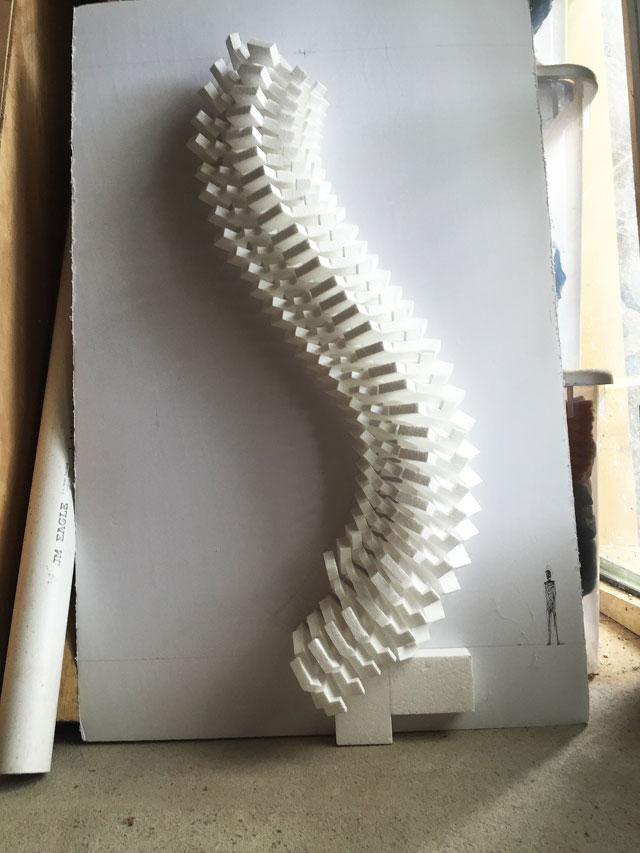
The very first model for Lanchals. Image courtesy John Powers.
AMc: Can you tell me a bit about the process of planning and making the work?
JP: My preparatory sketches are usually quite simple: a circle, a scribbled arc, a pile of lines. I try not to over-plan, because inevitably I work improvisationally. I’ll start with some very simple idea: a ring, a line, an S-curve, that I move away from, rather than a destination I aim to reach. Often, I think that “initial condition” I have chosen will do one thing, but it ends up surprising me. I was nicely surprised by Lanchals. Because of its scale and complexity, I worked for a year on various preparatory models for this project. The first was made from solid polystyrene blocks glued to a board, then I did a series of digital renderings with an architect friend and, finally, I spent almost a full year on a three-metre-tall wooden maquette – which is on display along with some other small works in the Poortersloge – that was made of thousands of basswood parts and bamboo dowels.
,-2018.jpg)
John Powers. Maquettes in the Poortersloge, Bruges Triennial © VisitBruges | Jan D’hondt.

Stack of modules for Lanchals, each individual joint drilled and dowelled using bamboo skewers and toothpicks. Image courtesy John Powers.
AMc: How does Lanchals fit into your practice as a whole? How similar is it to your usual style of working?
JP: After all the prep work I did, when I arrived to build the tower itself, all I brought with me to Bruges was a drawing of the S-curve I’d been using to make the models. Again, the “initial condition”. My plan, when I began work on the basswood maquette, was to use it as a plan, or maybe, if I am being totally honest, a bludgeon, to guide the fabrication. I wanted to walk into the shop and have a free-standing structure that I could point to, that worked (digital renderings aren’t subject to gravity and can’t be pushed to test their strength). But while the structure of my wood maquette was strong, it was too complex; unworkable at the scale we were working on. So, instead, I did what I have always done, which was to improvise.
I spent the first day getting to know the two Art-X fabricators I worked with, Chente de Waele and Mathijs Reymer, by welding up a totally new maquette with them, explaining my thinking as we worked. We repeatedly tweaked the maquette for the next week or two as we worked on the tower and ran into problems that needed to be solved. But that first day, day-and-a-half, of work was the basis of all the work we did together. And while I spent the first few days assuring the guys that if we did it my way, it would all work out (and if it didn’t, I would agree to any changes they insisted on), by the second week they were pushing me to adhere more strictly to my own ethic of construction – which was fantastic.
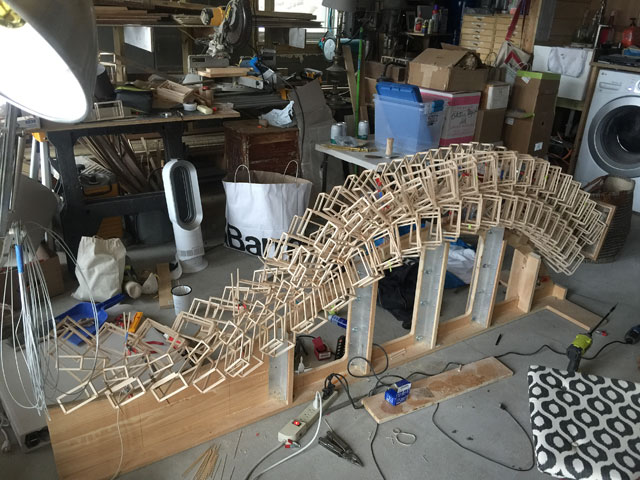
Basswood maquette for Lanchals, cradled horizontally on its jig, built in John Powers' workspace in New York. Image courtesy John Powers.
AMc: What is Lanchals made from and how did it get put together? Where was it constructed?
JP: We made the piece from stock square tube steel. I haven’t picked up a welding torch since I stopped casting bronze 23 years ago, but had been working in a way with wood for the past few years that I knew would translate well into metal. I was excited to try it out; to see what we could do. The individual modules we used, or “frame-blocks”, were made in advance by a fabricator in Poland that one of the other artists, Jarosław Kozakiewicz, recommended. They made five different sizes of frame-block. The largest, which are at the core of the piece, are about a metre long. The smallest are a third of that size. The individual frame-blocks were all the same shape that I have been working with since 1995. Each is a proportion of 1 x 2 x 3 – additionally, the stock square tube steel they were made of became proportionally smaller for each set. The modules were shipped to a workshop, located just outside the old city of Bruges, and it’s there that the tower was fabricated.
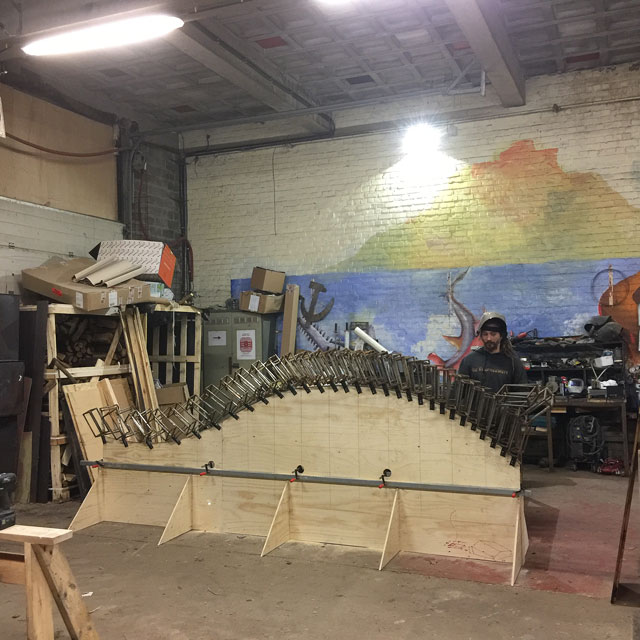
John Powers. Steel maquette built on the first day of production in Bruges. Image courtesy John Powers.
As I understand it, the old city of Bruges is a Unesco World Heritage Site, so there is no way to permanently alter the character of the city centre (with a 15-metre-tall work of abstract art, for instance), which is why all the works in the triennial are only up until September. After that, the sites will be returned to their former selves. That restriction means that all the structures have to have as minimal a footprint as possible. Additionally, the size of the piece was constrained by the fact that it had to enter the city through an historic arched gate and be manoeuvred to the site through narrow twisting streets. All sculpture has these sorts of constraints – as a gallery artist, I am used to dealing with the limits of truck capacity, loading docks, the heights of elevators, the widths of hallways and doorways. Even if we had built the tower inside the old city, this constraint would have held, as eventually the work would have needed to be removed.
Lanchals was fabricated in situ. This is a term I’ve borrowed from archaeologists. They use it to describe an artefact that has not been moved from its original place of deposition. To work in situ – to conceive and build a sculpture where it is shown, with the people who live and work in that place – is difficult. On one of the first days, when I asked for something, one of the guys teased: “You’re the boss,” to which I replied: “No, I am clearly the least boss of anyone here. You aren’t paid by me, this isn’t my shop, or my tools.” I wasn’t complaining. There are many ways to imagine what it means to be an artist and one is as “the boss”, who has a vision, and must be in control of every aspect of realising that vision. It’s not bad to be the boss. I like working with assistants, in my own shop, with my own tools – but, even then, I think of myself as a mentor, not the boss. In my experience, to work in situ is to abandon the role of boss entirely. Perhaps because I started my career as a craftsman, working for artists, I like that relationship to be one of equals, and I find the craftsmen I work with appreciate that – but abandoning the authority of the boss can be scary.
The best analogy I have for fabricating sculpture in situ is teaching a group of strangers a party game. It can be tricky to communicate the rules, everyone needs to play along for the game to work, and the success of the game is in no way guaranteed – after all, these people don’t know me. There was a moment in Bruges when I felt the game take on a life of its own, when the players – Santi, Chente and Mathijs especially – were no longer going along with the rules because they were the rules, but instead because they were enjoying the game for its own sake. The tower that we built together is something much better, much more refined, than what I would have produced alone, or if I were totally in charge of every decision.
AMc: Did you encounter any problems along the way?
JP: The work went very smoothly. Working on a piece that large, that weighs as much as this, I was most anxious about safety. I couldn’t be happier with how things went.
AMc: It seems to be quite a precarious structure.
JP: Elegance, by its very nature, is precarious. I worked to keep Lanchals as light and airy as possible within the bounds of the physically possible – and the bounds of the physically possible included not just the material we used, but the time we had to work, the space we had to work within, as well as the size that the route through the narrow twisting city streets (and the medieval gate) would allow.
AMc: Do you often respond to site-specific histories?
JP: Indirectly. I like titles that play with the history of titles. American abstract artists, especially the minimalists and those who followed, had a habit of choosing macho, often sinister or violent titles (Frank Stella’s painting Arbeit Macht Frei leaps to mind). But those ideas were communicated to me critically by feminist thinkers such as Anna Chave and Valerie Jaudon. My own interest with abstraction began with the rigour of those postwar movements, but quickly spread backwards to the less rigorous beginnings. The failed utopian aspects – transcendent form, universal visual languages, empathy, neutrality and even the earliest of all chestnuts, “absolute decoration” (beauty is undervalued).
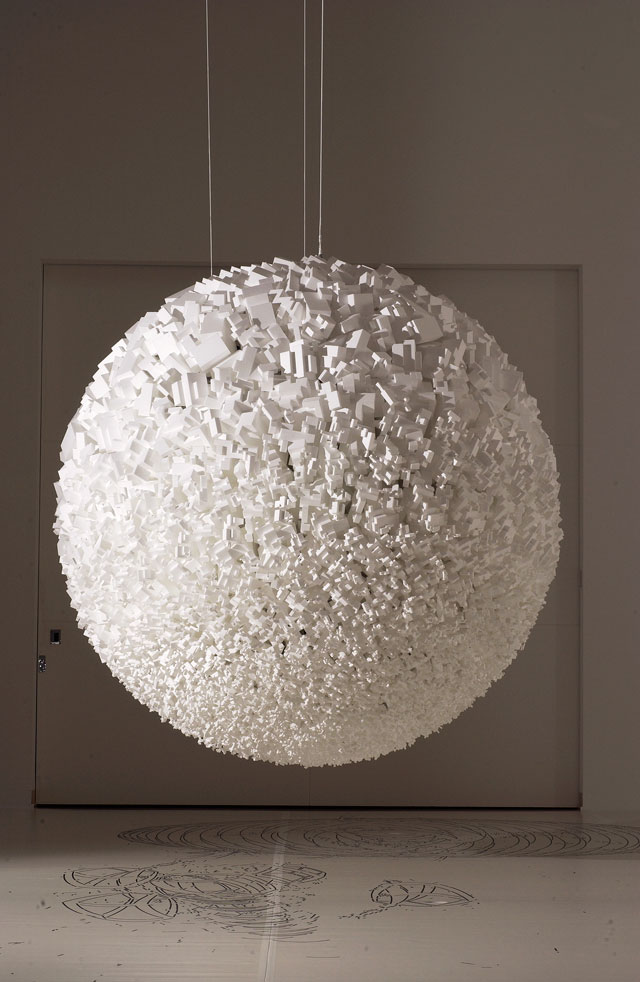
John Powers. Terminal, 2004. Polystyrene blocks, 244 x 244 x 244 cm (8 x 8 x 8 ft). Image courtesy John Powers.
In the past, I’ve chosen titles such as “Daisy Cutter” (a particularly horrible variety of bomb being used at the time in Afghanistan), “Rampart Division” (an infamously corrupt division of the Los Angeles Police Department, busted not long before I used the title) and “Terminal” (a private evergreen wink at the Death Star). These were all titles that were meaningful in their political moment, that could be read as formal descriptions, that also stretched back to a moment in art history that interests me personally, but were hung on works that I found particularly beautiful and elegant. (Perhaps because I want to make clear that beauty isn’t a weakness, it isn’t passive, it is a form of power.) So, likewise, with Lanchals referring, simultaneously, to long-neck swans and a beheading.
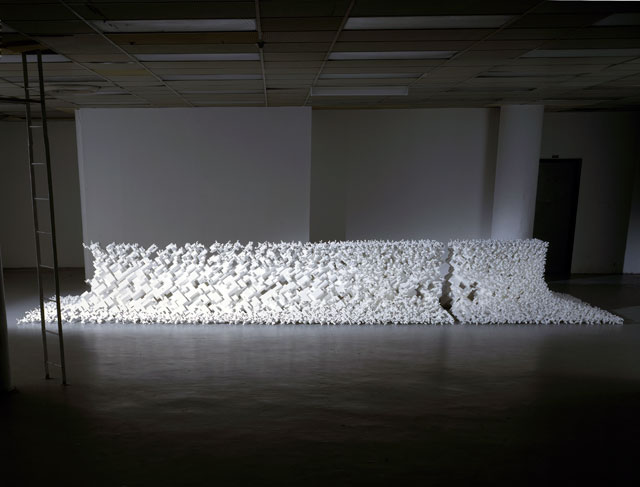
John Powers. Rampart Division, 2002. polystyrene blocks, 122 x 244 x 914.5 cm (4 x 8 x 30 ft). Image courtesy John Powers.
AMc: How did you select the specific location for Lanchals?
JP: I didn’t. It wasn’t important to me that I should. What was important to me was the relationship between the work and the canal – the edge condition of that space physically, but also as a historical space. I wanted the work to be visible from below, by tourists passing by on boats, but I also wanted it to be approachable on the ground plane. I trusted the people I was working with and we had long discussions about what I wanted for the piece, and while I didn’t end up with exactly what I asked for (I wanted to be closer to the edge of the canal than the authorities would allow), I am very happy with the space chosen. The site they chose is what we might call a pocket park in New York – a kind of space used mostly by locals. Minneboplein, the park the piece is in, is tucked away from the paths tourists usually take and is used by the people in the neighbourhood as a dog run.
AMc: How has the response to your work been in the city? From the locals? And from visitors?
JP: I’m not there and haven’t heard much since I left – but I think I would have heard if there were problems or complaints … While I was there for the opening, the people I spoke to told me they were happy with it, and everyone seemed pleased. I very much hope that reflects a general attitude. I stayed in Bruges with my fiancee and our dog for almost a month. During that time, I got to know some of the staff of the triennial, the fabricators, our landlords, a couple of wonderful publicans. The work wasn’t done in a public space, so the people I know there most intimately are the people I had a chance to talk to about what I was doing and why.
Often my experience – when I’ve worked with strangers in a strange land, be it Kansas, Hong Kong, or Russia – has been that I am initially greeted with wariness. Even in the art world, the title of “artist” has all kinds of very positive and negative connotations. I work not so much to win people over but to make them forget what they think an “artist” is; to let go of that wariness. That is perhaps the sculptural equivalent of playing to the band – that if I am able to make something that the people working with me love, that that is my best chance to know I am making something meaningful for the rest of their community. On those terms, I left Bruges feeling that the work had gone very well.
AMc: What role does the concept of infinity play in your work?
JP: Endless columns. I’ll never get there, but the idea of always using the same shape is, I like to think, a nod to the infinite – or at least to the endless. For the past quarter of a century, I have done one thing. To my mind the objects and installations I show aren’t discrete works, they are markers within a greater project. That idea, of a lifetime’s work as a single flow of activity, is something I can remember looking forward to looking back on since I first decided I wanted to be a sculptor in my late teens.
AMc: How does Lanchals respond to the theme of the triennial, namely Liquid City?
JP: I made a number of associations to the theme before I’d read Till’s text and made the connection to [the Polish philosopher] Zygmunt Bauman or visited the city. My imagination went to ideas of liquidity – of currency. The city as a wealth generator. (Adam Smith wrote The Wealth of Nations, not The Wealth of Billionaires.) But when I first walked around the city centre and began to get a sense of its encircling canals, I reversed myself. I made associations with Thomas More’s Utopia – an island cut off from the world by a canal. A perfect place with social housing and Europe’s first public hospital (if I’m not misremembering). More hated the vulgarity and the chaos of modern city life, however – and I don’t at all. He reimagined the city as a monastery, that was his idea of perfection – which sounds awful to me. So, while he’s a good foil, he’s not much of an inspiration.
Once I saw the place, I played with a number of ideas for starting points for my proposal – barges, bridges, towers, not sure what else. I settled on a tower, perhaps because of my very first association with wealth, but probably more so because of something Santi told me on our first tour of the city. I had assumed that the belfries were all church towers, and must have commented to that effect, but he corrected me. Most of the towers in Bruges are just towers, built by rich people. Again, I was stopped short. I asked him why and he shrugged and told me it was so they could show their wealth. That surprise, that the belfries were conceptually closer to skyscrapers than to church towers, is where my imagination settled – and, that the very tallest tower, the Belfry, was an expression of civic wealth: exactly as the work I was being commission to make would be.
AMc: What will happen to Lanchals after the duration of the triennial? Could it ever be shown elsewhere?
JP: I’m open to that. There’s no plan at this time, but I would like it to have a life beyond the triennial. When I began making art there was still an enormous conceptual fuss being made over the idea of sculpture and installation as “site-specific” – presumably the work given that honorific would be made for a certain place, and even a particular time. It’s an idea with its origins in 60s formalism, but it has stretched well into the new millennium. I remember thinking as a young artist that the whole thing seemed a bit overblown, but I made work that was arguably site-specific, so I didn’t question the fuss. I’d build things in the gallery, out of loose stack blocks, and them knock them down when I was done. Site-specific. (About half my output is still temporary installation.) But still the term rubbed me wrong. When Richard Serra, a sculptor I admire, declared in 2007 that his work Band was site-specific to both the Museum of Modern Art in New York and the Los Angeles County Museum of Art, I felt the term had gone from art-theory dog-whistle to false flag.
AMc: What are you working on next?
JP: Small stuff.
• Lanchals can be seen at the Bruges Triennial until 16 September 2018.